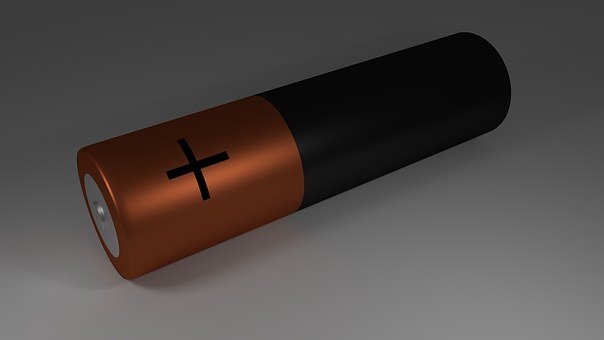Most AA, AAA, C, and D cells have a nominal voltage of 1.5 volts, which is used in a variety of household and handheld devices. The first zinc-carbon dry cells produced 1.5 volts of energy spontaneously, and this has remained the standard since then.
Let’s begin with learning more about a 1.5v battery.
How Does A 1.5-Volt Battery Appear?
In modern homes, 1.5-volt batteries are extremely popular. 1.5 volts is without a doubt the most frequent voltage for our batteries. Saline batteries have been phased out in favor of alkaline batteries.
Your everyday things, like portable lamps and radios, require a 1.5 volts battery, so you should be familiar with it to guarantee you are purchasing the correct item and not inviting problems into your home.
Typically, 1.5-volt batteries are cylindrical, having one positive and negative end, much like any other circuit. They come in a variety of shapes and sizes, and there are numerous brands to choose from.
The 1.5 V batteries offer a great energy-to-weight ratio and have a voltage of 1.5V. Furthermore, an alkaline electrolyte is used to provide a voltage for the battery, and silver-oxide and zinc are commonly used in the electrode.
The subject of whether or not 1.5 V batteries can be recharged in mobile devices is a common one. Please don’t be concerned.
Here, too, I’ve got you covered. After use, the 1.5 V batteries are usually supposed to be thrown away. Make sure you’re not attempting to re-energize them.
Your risk may cause an explosion and injuring yourself or your loved ones, and the recharging process is ineffective. The rechargeable batteries are available in voltages of 1.2 volts, 3.6 volts, 7.2 volts, and higher.
What is Common between Lithium-ion batteries and Lithium 1.5 V batteries?
What’s in common here, considering the need of distinguishing between lithium-ion and lithium 1.5 V batteries? The battery is made of lithium, which makes it a very powerful and long-lasting cell type.
These batteries are commonly used in high-drain electronics like digital cameras for more durable, shorter-term use. However, you may always use it for low-power devices that need to be turned on for extended periods, such as smoke alarms. They have around a 9-year shelf life.
Alkaline 1.5 V batteries, on the other hand, are the ‘standard’ type and are required by almost all low-powered consumer electronics devices.
Many gadgets and technologies rely on alkaline AA batteries, which provide cost-effective mid-tier cell power.
Wall clocks, games and toys, miniature flashlights, TV remotes, and a variety of other technology are examples. They are inexpensive and conveniently accessible for short-term use.
What size is a 1.5-volt battery?
1.5 V batteries are available in a variety of sizes and types. It is often observed that AA batteries are the most often used 1.5 V battery size. There are, however, other sizes available for various types of gadgets and technologies. Here’s a standard chart to help you understand the different sizes of 1.5V batteries and figure out which ones you’ll need for your gadgets.
Aside from that, you may acquire the batteries in size N, which is also cylindrical, with dimensions of L 30.2 mm and D 12 mm. Different brands may call these batteries by different names. Other names for 1.5 V batteries that may help you choose the proper 1.5 battery are listed below.
What is a 1.5V battery used for?
Without a doubt, 1.5 V batteries are widely employed in a variety of electronic devices around the world. They are mostly utilized in handheld devices such as remote controls and toys. Lithium batteries are ideal for high-drain devices since they do not leak and can be used for years. As a result, lithium 1.5 V batteries are widely used in digital cameras and alarm systems. You probably need to double-check the appropriate size for the capacity and power of your device. However, you can rest assured that these batteries will keep you worry-free for a longer period.
Alkaline 1.5 V batteries, in contrast, are commonly used in handheld devices such as television remotes and children’s toys.
Wall clocks, cordless phones, and non-main accent lighting all need alkaline batteries. The 1.5 V AA batteries are also required by compact torches, kitchen devices, grooming gadgets, and portable audiovisual technologies. These are the standard batteries, and you should have a few spares in your house. Any everyday device can request it at any time.
Is it possible to recharge 1.5-volt batteries?
When you do usually have a few 1.5v lithium-ion and lithium-polymer batteries in stock, the great majority are non-rechargeable alkaline, zinc, or lithium batteries that are supposed to be thrown away after one usage. 1.2v, 3.6/7v, 7.2/4v, or higher voltages are found in most rechargeable batteries.
Final Words
In short, the majority of AA, AAA, C, and D cells have a nominal voltage of 1.5 volts. You’ve probably heard about the first-generation -carbon dry cells. Naturally, they were the first to create 1.5 volts of energy, and they have been standard ever since.
Alkaline and lithium batteries with a voltage of 1.5 volts are available. When comparing the two types of batteries, alkaline 1.5 V batteries have a higher capacity and are preferable for powering high-stress gadgets.
I hope you found this article to be informative. Please forward it to everyone if this is the case.
Related Posts:


